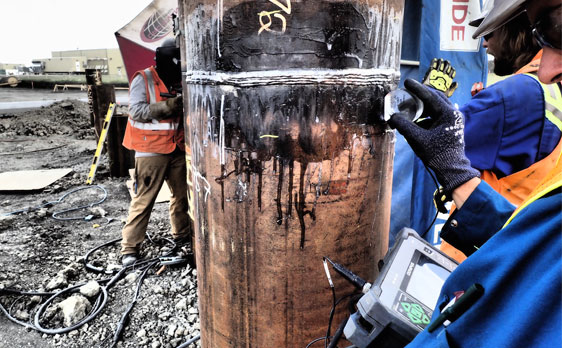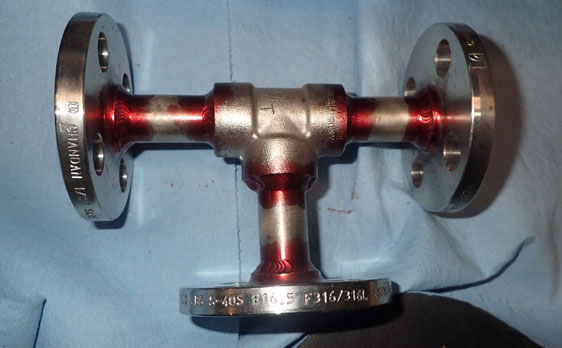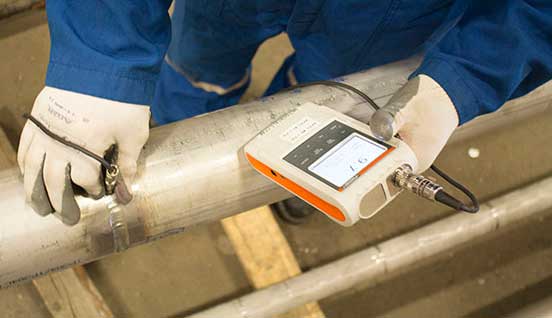Non-destructive Examination

Ultrasonic Testing
Ultrasonic testing uses high-frequency sound energy to perform examinations and make measurements. Ultrasonic testing may be used for dimensional measurements, thickness, material characterization, flaw detection, and more.
Advances in ultrasonic testing have taken place in recent times, evolving from the conventional thickness application to the use of more advanced methods encompassing various modes.
Ultrasonic Thickness Testing
Manual ultrasonic thickness measurements is a technique using high-frequency sound energy to conduct examinations and obtain thickness measurements. A straight beam is introduced into the test object perpendicular to the surface and round-trip time is measured. Quantifiable information can be gathered for detection of localized Corrosion or general wall-thickness changes.
Ultrasonic Flaw Detection : (Shear wave inspection)
The use of ultrasonic shear waves has all the advantages of weld inspection with no inherent safety concerns, no disruption of production due to radiation hazards, near real-time inspection results, and vertical defect sizing for engineering critical assessments. Information can be obtained on surface and subsurface indications detrimental to the end use of components. A high degree of accuracy can be achieved in estimates of discontinuity size, shape and orientation. The technique requires access to only one side of the component, with minimal specimen surface preparation.
Automated Ultrasonic Corrosion Scanning-(AUT)
Automated ultrasonic C-scan is a technique that utilizes ultrasound and mechanized scanners to build a comprehensive plan view of the component being inspected. Typical plan-view imaging is displayed in color-coded maps according to the thicknesses obtained throughout the inspection area. Calibrated dual-axis encoders provide a scale map to measure the lengths and widths of the indications found.
Automated ultrasonic C-scan can be employed on a variety of equipment components, providing detailed corrosion-mapping thickness data. The information provided can be used to calculate remaining life and retirement dates.
Major Client benefits:
Automated C-scan inspections provide substantial amounts of quantifiable thickness data. When conventional UT thickness measurements are taken usually a small area is surveyed and an average low is recorded for client info. With the AUT Examination Millions of recorded measurements are recorded and provide a much broader resolution to the client for acceptability. The resolution of the examination area can be adjusted to suit the client’s needs for classification, calculations and other requirements.
With improved defect detection and rapid component coverage, Reports from the resulting data are easily interpreted by untrained end users and can be retrieved for further review by client inspectors and engineering personnel. Clarity Inspection Can offer all types of of conventional and advanced ultrasonic inspection such as Phased-array flaw detection and AUT corrosion scanning.
Our technicians are trained in accordance with a written practice that complies with ASNT-SNT-TC-1A

Magnetic Particle Testing
Magnetic particle testing is a simple test method that can be applied to ferromagnetic materials including in-progress & finished Welds, castings and forgings. Magnetic particle testing requires magnetizing the piece to be examined, applying the inspection medium or particles, and interpreting the patterns formed by the particles when they are attracted to the magnetic leakage field created by discontinuities in the part. Particles may be visible or Fluorescent.
Clarity Inspection offers both visible method as well as fluorescent method to our clients in the field. Our technicians are trained in accordance with a written practice that complies with ASNT-SNT-TC-1A

Liquid Penetrant Testing
Liquid penetrant testing is one of the most widely used non-destructive testing methods. LPT is based on capillarity or capillary attraction, where a liquid is able to flow into narrow spaces without the assistance of or even in opposition to external forces such as gravity. The materials processes and procedures used in liquid penetrant testing are designed to make the results of this capillary action visible and capable of interpretation.
Liquid penetrant testing is an effective means of locating and determining the severity of surface discontinuities in materials, including those that are not visible to the naked eye.
Liquid penetrant testing is very effective in locating manufacturing defects such as cracks & pinholes as well as in-service discontinuities such as :
- Fatigue cracks
- HIC
- SOHIC
- SCC
Clarity Inspection offers both visible method as well as fluorescent methods of Liquid penetrant testing to our clients in the field. Our technicians are trained in accordance with a written practice that complies with ASNT-SNT-TC-1A

Ferrite Testing
Ferrite testing is a fast, inexpensive, and accurate way to measure delta ferrite content in austenitic and duplex stainless steels. Proper ferrite content provides a balance between ductility, toughness, corrosion resistance and crack prevention.
Heat, pressure and caustic environments require materials and welds with very high metallurgical integrity. A correct ferrite measurement can help to avoid both solidification cracking and corrosion in stainless steel welds, pipes, plates, pressure vessels and petrochemical components.
When ferrite content is too high, stainless steel can lose ductility, toughness, and corrosion resistance – especially at high temperatures. If ferrite content is too low, stainless steel welds become susceptible to hot cracking or solidification cracks. In duplex stainless steel welds, a deficit of ferrite content can also reduce weld strength and contribute to the development of stress corrosion cracks.
Clarity Inspection can perform Ferrite testing in the field and ensure that fabrication and repairs adhere to client/Material’s specific guidelines. Clarity uses the Fischer FMP30C for shop and field ferrite testing.

Hardness Testing
Clarity Inspection can provide shop or field Digital Hardness testing to ensure material compliance to specifications prior to and after welding or heat-treatment. Clarity uses the BAQ AlphaDur Mini, The new and improved replacement for the discontinued MIC 10. The AlphaDur Mini allows the Testing of machine parts, weld seams, HAZ, coatings and hardened parts, even at difficult to access locations and at any angle.

